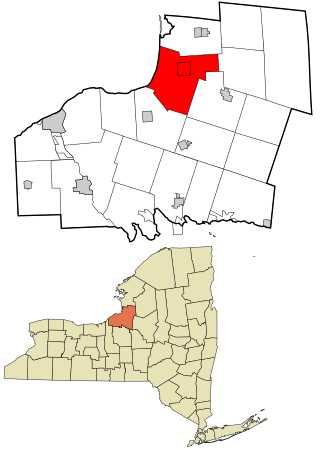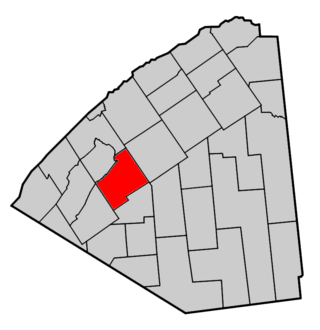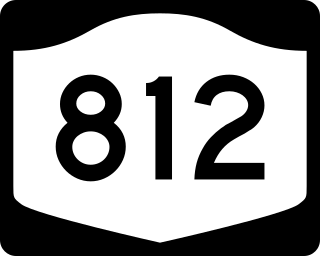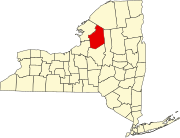
Venice is a town in Cayuga County, New York, United States. The population was 1,368 at the 2010 census. The town is in the southern part of Cayuga County and is south of Auburn.

Litchfield is a town in Herkimer County, New York, United States. The population was 1,513 at the 2010 census. The town is named after Litchfield, Connecticut, the source of some early settlers of the city.

Natural Bridge is a hamlet and census-designated place (CDP) in Jefferson County, New York, United States. As of the 2010 census it had a population of 365.
Harrisville is a hamlet and former village in Lewis County, New York, United States. The community is now a census-designated place. The population was 628 at the 2010 census.
New Bremen is a town in Lewis County, New York, United States. The population was 2,706 at the 2010 census. The town is named after the German city of Bremen.
Watson is a town in Lewis County, New York, United States. The population was 1,802 at the 2020 census. The town is named after early landowner James Watson. The town is at the eastern border of the county and is east of Lowville, the county seat.

Forestport is a town in Oneida County, New York, United States. The population was 1,477 at the 2020 census.

Richland is a town in the northeastern part of Oswego County, New York, United States. The population was 5,718 at the 2010 census.

Clifton is a town in St. Lawrence County, New York, United States. The population was 675 at the 2020 census. The town takes its name from a mining company.

DeKalb is a town in St. Lawrence County, New York, United States. The population was 2,375 at the 2020 census, down from 2,434 at the 2010 census. The town is named after American general Baron de Kalb, a German officer serving under George Washington.

DePeyster is a town in St. Lawrence County, New York, United States. The population was 998 at the 2010 census. The name is taken from that of one of the land owners of the region, Frederic de Peyster, grandfather of John Watts de Peyster.

Fine is a town in St. Lawrence County, New York, United States. The population was 1,512 at the 2010 census. The town is named after Judge John Fine, a businessman involved in settling the town.

Fowler is a town in St. Lawrence County, New York, United States. The population was 2,202 at the 2010 census.

Oswegatchie is a town in St. Lawrence County, New York, United States. The population was 4,397 at the 2010 census. The name reportedly means "Black Water". It is on the northern border of the county and is adjacent to the city of Ogdensburg.

Pitcairn is a town in St. Lawrence County, New York, United States. The population was 846 at the 2010 census. The name is from that of Joseph Pitcairn, an early landowner and diplomat.

Plattsburgh is a town in Clinton County, New York, United States. The population was 11,886 at the 2020 census. The town is named after Zephaniah Platt, an early land owner, and it surrounds the separate and more populous city of the same name. The town is in the eastern part of the county, in the North Country region of the state of New York. The region's airport, Plattsburgh International Airport, is located in the southern part of the town.
Antwerp is a town in Jefferson County, New York, United States. The population was 1,683 at the 2020 census. The town is named after Antwerp, Belgium, the home of the early investors in the town, who had organized under the name of the Antwerp Company.

Croghan is a town in Lewis County, New York, United States. The population was 3,093 at the 2010 census. The town is in the northern part of the county and located northeast of the county seat, Lowville. The town contains a village also named Croghan, a small part of which is located in the adjacent town of New Bremen. Both the village and town are locally pronounced \Krō-gun\.

Gouverneur is a town in St. Lawrence County, New York, United States. As of the 2020 census, the population was 6,551. That was down from 7,085 in 2010. The town is named after statesman and landowner Gouverneur Morris.

New York State Route 812 (NY 812) is a state highway in the North Country of New York in the United States. The southern terminus of the route is at an intersection with NY 12 and NY 26 in the Lewis County village of Lowville. Its northern terminus is at the Canada–United States border in Ogdensburg, where it crosses the Ogdensburg–Prescott International Bridge and connects to Highway 16 in Ontario. While most of NY 812 passes through rural areas of the North Country, the route also serves several villages and small communities. The GPS services company Geotab has named it the quietest highway in New York due to its low traffic counts.


















